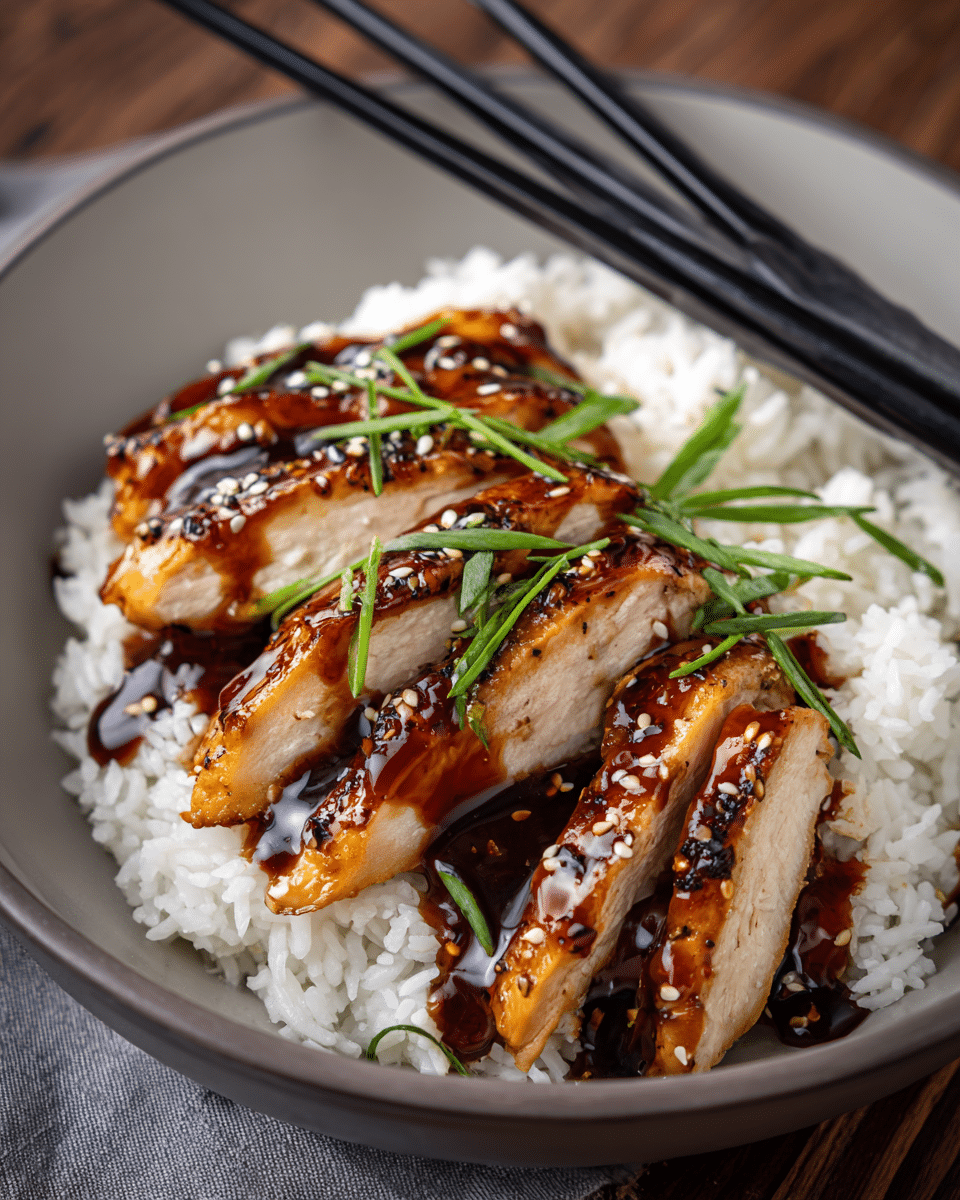This Homemade Teriyaki Chicken Breast recipe is a quick and flavorful way to bring Asian-inspired cuisine to your dinner table. Juicy chicken breasts are pan-seared and glazed with a sweet, savory, and slightly sticky teriyaki sauce that’s made from scratch—no bottled sauces here! Ideal for busy weeknights, this dish pairs beautifully with steamed rice, sautéed vegetables, or noodles, making it a versatile favorite that’s both healthy and satisfying.
FULL RECIPE
Ingredients
- 2 large boneless, skinless chicken breasts
- Salt and black pepper, to taste
- 1 tablespoon vegetable oil
- ¼ cup low-sodium soy sauce
- 3 tablespoons honey or brown sugar
- 2 tablespoons rice vinegar
- 2 tablespoons water
- 1 tablespoon cornstarch
- 1 teaspoon sesame oil
- 2 cloves garlic, minced
- 1 teaspoon grated fresh ginger (or ½ teaspoon ground ginger)
- Optional garnish: sesame seeds, chopped green onions
Directions
- Slice chicken breasts in half horizontally to create four thinner cutlets. Season both sides lightly with salt and pepper.
- In a small bowl, whisk together soy sauce, honey (or brown sugar), rice vinegar, sesame oil, garlic, ginger, and water. In a separate bowl, mix cornstarch with a splash of cold water to make a slurry.
- Heat vegetable oil in a large skillet over medium heat. Add chicken cutlets and sear for 3–4 minutes per side until golden and cooked through (internal temperature should reach 165°F/74°C). Remove from the pan and set aside.
- In the same skillet, pour in the soy sauce mixture. Bring to a simmer over medium heat, then stir in the cornstarch slurry. Cook, stirring, until the sauce thickens (about 1–2 minutes).
- Return the cooked chicken to the skillet and coat each piece in the teriyaki sauce. Let simmer for 1 more minute to fully absorb the flavor.
- Remove from heat, garnish with sesame seeds and green onions if desired, and serve immediately.
Nutrition Facts
- Calories: 260
- Total Fat: 9g
- Saturated Fat: 1.5g
- Cholesterol: 75mg
- Sodium: 650mg
- Total Carbohydrates: 14g
- Dietary Fiber: 0g
- Sugars: 11g
- Protein: 30g
Health Benefits of Chicken Breast
Chicken breast is widely considered one of the healthiest protein sources available. It’s low in fat, especially when skinless, and high in lean protein, which helps support muscle growth, repair tissues, and maintain satiety. In this recipe, using chicken breast keeps the meal relatively low in calories while delivering essential nutrients such as niacin, vitamin B6, phosphorus, and selenium. When prepared with minimal oil and sugar, homemade teriyaki chicken can be a nutritious part of a balanced diet. It’s especially popular among athletes and those following low-carb, high-protein, or calorie-conscious eating plans.
Making a Healthier Teriyaki Sauce
One major advantage of homemade teriyaki chicken is controlling the sauce ingredients. Many commercial teriyaki sauces are loaded with refined sugars, MSG, and high sodium levels. By making your own, you can adjust sweetness with natural alternatives like honey or maple syrup, reduce sodium with low-sodium soy sauce, and even add more nutrients with fresh ginger and garlic. You can also include a splash of citrus juice or use coconut aminos as a soy-free option. Customizing the sauce not only makes it healthier but also enhances the flavor and gives the dish a fresh, homemade quality that’s hard to replicate with store-bought varieties.
Ideal Cooking Techniques for Perfect Chicken
Cooking chicken breast to perfection requires a balance of heat and timing. For this dish, slicing the breasts into thinner cutlets ensures quicker, more even cooking and prevents drying out. Searing the chicken in a hot skillet develops a caramelized exterior that complements the teriyaki glaze beautifully. It’s important not to overcrowd the pan, as this can cause steaming instead of browning. Once the chicken is cooked through, letting it rest briefly allows the juices to redistribute, preserving moisture. Returning it to the skillet with the glaze for a final coating gives it a glossy finish and concentrated flavor.
Creative Variations on Teriyaki Chicken
Homemade teriyaki chicken is highly adaptable. You can experiment with different proteins such as salmon, tofu, shrimp, or beef for alternative versions. Adding chopped vegetables like bell peppers, broccoli, snap peas, or mushrooms directly to the skillet transforms the dish into a stir-fry-style meal. For a spicier kick, a touch of sriracha or red pepper flakes can be added to the sauce. Pineapple juice or fresh orange zest adds brightness and tropical flair. Gluten-free options are easy to create using tamari or coconut aminos in place of soy sauce. These variations keep the dish exciting and suitable for different dietary needs.
Serving Suggestions and Side Pairings
Teriyaki chicken pairs beautifully with a range of sides, making it a versatile dinner option. The most traditional accompaniment is steamed white rice, which soaks up the flavorful sauce. For a healthier twist, try brown rice, quinoa, or cauliflower rice. Stir-fried or steamed vegetables like bok choy, green beans, or carrots add color and nutrition. Noodles, such as soba or rice noodles, can also serve as a hearty base. To elevate presentation, garnish with sesame seeds and chopped green onions. For a complete Asian-inspired meal, serve alongside miso soup or a cucumber salad dressed with rice vinegar and sesame oil.
Meal Prep and Storage Tips
Homemade teriyaki chicken is excellent for meal prep and stores well for several days. After cooking, allow the chicken to cool completely before transferring to airtight containers. It can be refrigerated for up to four days or frozen for up to three months. To freeze, consider storing individual portions to make reheating easier. When reheating, use a microwave-safe dish with a splash of water or cover with a damp paper towel to keep it moist. For stovetop reheating, warm gently over low heat and add a little extra sauce if available. Proper storage ensures both safety and taste integrity throughout the week.
Making It a One-Pan Meal
Transforming this recipe into a one-pan dinner is both practical and time-saving. After searing the chicken, remove it temporarily and toss vegetables like broccoli florets, sliced bell peppers, or snow peas directly into the skillet. Once the vegetables are slightly tender, return the chicken to the pan and pour in the sauce. Simmer everything together until the sauce thickens and all ingredients are evenly coated. This approach simplifies cooking and clean-up while still delivering a nutritious, flavor-packed meal. One-pan teriyaki chicken is ideal for busy weeknights when efficiency is a priority but quality and taste can’t be compromised.
Cultural Relevance and Global Popularity
While rooted in Japanese cooking traditions, teriyaki chicken has become a global favorite, especially in Western countries where it’s a restaurant and takeout staple. It’s widely appreciated for its approachable flavor and compatibility with local ingredients. In Japan, teriyaki dishes are often more subtly sweet and used on fish or tofu. In contrast, Western versions lean toward a more robust, syrupy glaze that appeals to broader tastes. The global popularity of teriyaki chicken has inspired countless adaptations and fusion dishes, making it a symbol of culinary cross-cultural appeal. Its success lies in its simplicity, flexibility, and universally loved flavor profile.
Advertisement
Conclusion
Homemade Teriyaki Chicken Breast is a dish that delivers both comfort and convenience without compromising on flavor. With its tender, juicy chicken and glossy, homemade glaze, it’s a recipe that feels indulgent yet remains wholesome and customizable. From its roots in Japanese cooking to its place on modern dinner tables, teriyaki chicken continues to win hearts worldwide. Whether you’re feeding a family, prepping for the week, or just craving a quick Asian-inspired meal, this versatile recipe fits the bill. By mastering the basics and experimenting with variations, you’ll have a dependable favorite you’ll return to again and again.






